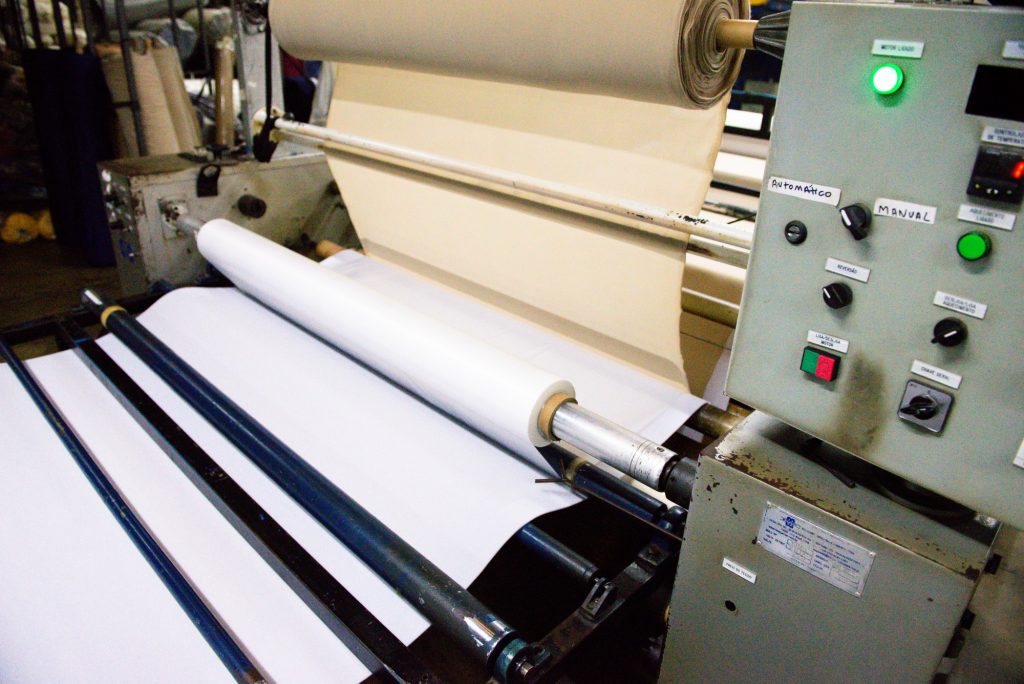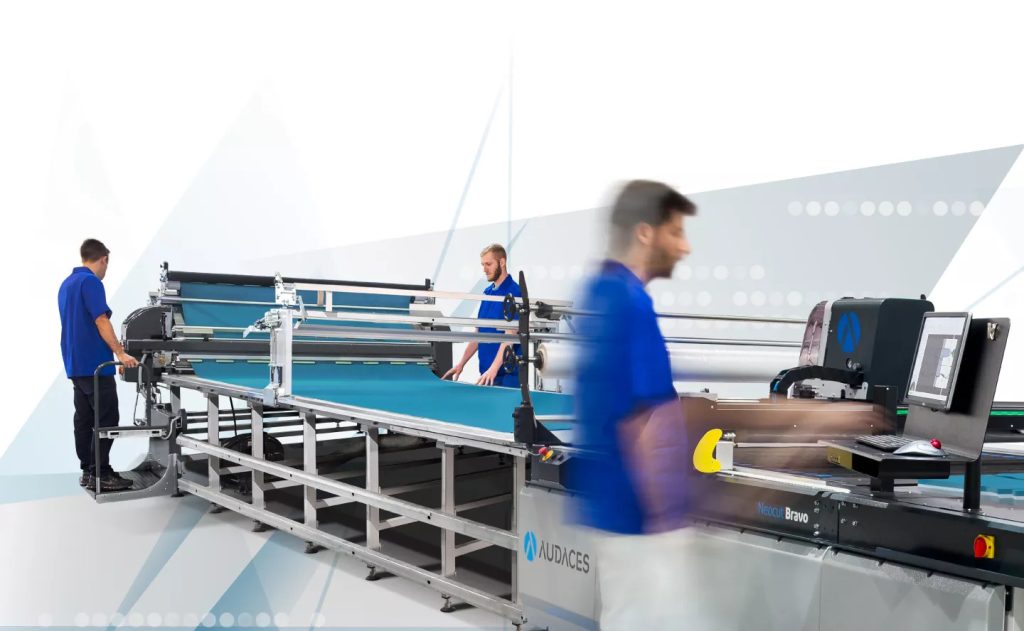Summary
- Bonded fabric involves fusing two fabrics using heat or adhesive
- This technique enhances sophistication and beauty in the end products
- Manage all stages of your production with the Audaces360 multi-solution. Sign up for the free trial now!
Bonded fabric is the result of a technique that is gaining popularity worldwide. It involves fusing two fabrics using an adhesive process, imparting enhanced durability and sophistication to the final product.
Are you interested in exploring this procedure further?
Discover more details about the bonding method, its mechanics, its significance within the textile industry, and its potential application in your fashion collection.
Continue reading the article below and enjoy your read!
Sumário
What is bonded fabric?
Bonded fabric is the result of merging two fabrics and adhering them together using lamination techniques.
This fusion imparts heightened durability and improved adaptability to the material.
This versatile method finds application across various product types, including the production of footwear and bags.
Typically, this process is employed when a product necessitates a robust outer fabric coupled with a softer, more comfortable, flexible, or moldable inner fabric.

What is the purpose of bonded fabric?
The objective of utilizing this type of fabric is to imbue items with heightened durability and sophistication. This implies that, beyond aesthetics, the resultant product enjoys an extended lifespan.
Depending on the specific piece undergoing this process, dual-sided utilization remains an option, enhancing versatility.
Moreover, this technique enables the augmentation of volume in the product, coupled with contemporary attributes, thereby enhancing its overall quality and aesthetic appeal.
Learn more: How to create a clothing color chart to elevate your collection
How is bonded fabric created?

Various methods exist for fabric bonding, encompassing:
- PUR hot melt adhesives
- Thermal bonding
- Chemical bonding
- Film bonding
Find out the advantages of each of the methods and their differences to choose the best option:
PUR hot melt adhesives
A prominent industrial process, PUR utilizes hot melt polyurethane glue as its primary component.
This adhesive type is well-suited for materials requiring flexibility and air permeability at the bonded regions.
Thermal bonding
Thermal bonding involves the fusion of thermoplastic fibers with each other or other fibers using thermoplastics.
In this technique, two fabrics are carefully heated and merged, resulting in a cohesive and enduring composite material.
The heat-activated adhesive effectively unites the fabrics, ensuring longevity and resilience.
Chemical bonding
Chemical bonding entails applying a “chemical binder” to join polyester and rayon fibers, imparting distinct and advantageous properties to nonwovens.
Through specialized adhesives or reactive agents, fabrics are chemically united. This process often enhances flexibility and strength while upholding structural integrity.
Film bonding
A slim adhesive film is placed between fabrics and activated using heat, creating a secure and uniform bond.
This method preserves the individual characteristics of the fabrics while enhancing their collective strength.
TPU films are widely employed for textile bonding. In the industry, garments can be made lighter (such as sportswear, lingerie, and swimwear) by using bonded seams instead of traditional stitching, guaranteeing greater flexibility and breathability.
Applications of bonded fabric in various products
This type of fabric finds versatile applications in a wide range of products, encompassing:
- Double-sided clothing
- Footwear
- Handbags
- Purses
- Necessaires
- Car upholstery
- Armchairs
- And various others!
Benefits of this technique

The application of bonded fabric technique spans various products and confers many benefits.
Explore a selection of the advantages in employing this method below!
Enhanced firmness and resilience
Firmness and resilience stand out as pivotal considerations when discussing bonded fabric.
When bonding two fabrics, their distinct textures contribute to heightened resistance, consequently potentially prolonging the useful lifespan of the final product.
Elevated coating quality
Utilized for coatings, the process of bonding imparts heightened strength to fabrics, imbuing them with a contemporary appeal and improved adherence to the chosen format and design.
This enhancement is achieved without compromising the inherent fabric quality, while also adding dimension to the piece, potentially enhancing its aesthetic allure.
Sophistication and elegance
The utilization of bonded fabric in crafting a piece can significantly augment its sophistication and exclusivity.
When executed meticulously, this technique bestows an air of refined elegance, extending the product’s durability.
However, achieving this outcome mandates the precise application of the bonding process by adept professionals possessing a profound understanding of harmonizing diverse fabric compositions.
Learn more: 9 fabrics with the perfect fit to use in your fashion collection
What types of fabric can be dubbed?
Discover the array of fabric types suitable for the bonding process and gain insights into their distinctive advantages:
Cotton
Cotton-based fabrics retain their original texture and breathability post-bonding, making them well-suited for this technique.
Denim
Renowned for its sturdiness, denim maintains its unique tactile qualities when used in bonded fabrics, without compromising its inherent quality or composition.
Satin
With its lustrous surface and supple feel, satin finds applications in various garment styles, including those that undergo bonding.
Its malleability makes it an ideal choice for this method, enabling effortless shaping.
Learn more: Learn all about satin fabric and how it can elevate your fashion production
Helanca
Lycra, a synthetic fiber-based fabric known for its elasticity, is a popular choice for bonding applications.
Learn more: Everything you need to know about helanca fabric
Linen
Flax, a timeless natural textile, finds its place in the realm of fabric bonding. Its inherent composition lends itself to the transformation of fabrics into more refined pieces.
Learn more: Find out how to use linen fabric in your fashion collection
Cotton Oxford
Oxford fabric, crafted from cotton, boasts substantial density. Consequently, it serves as an excellent candidate for reinforcing garment sections that demand heightened structural integrity.
Learn more: Get to know all about Oxford fabric and how to apply it in your collection
Tips for error-free handling of bonded fabrics

Achieving flawless outcomes when working with bonded fabrics requires meticulous attention to specific details.
Selecting high-quality fabrics is of paramount importance to achieve optimal results in your bonding endeavors.
Beyond adding a touch of sophistication and visual allure to your creations, this choice can foster customer loyalty by delivering impeccable finishes.
The fabrics chosen for bonding must establish a harmonious dialogue and uphold standards of quality.
Enhance precision with Audaces Cutting Room
If the pursuit of heightened precision, efficiency, and optimized time management aligns with your company’s objectives for fabric bonding, then the Audaces Cutting Room emerges as a compelling solution.
Seamlessly designed for the fashion industry, the Cutting Room is an innovative equipment to help you control your production processes with unparalleled convenience.
Audaces Cutting Room 4.0 orchestrates the precise cutting of fabric components through integration with intelligent equipment, which ensures real-time data exchange and enables remote access.
When we speak of the Audaces Cutting Room, we mean punctual deliveries and flawlessly cut fabric components.
This comprehensive solution includes an array of meticulously designed equipment:
Conclusion
Integral to perfecting and refining numerous articles, bonded fabric plays a pivotal role not only in fashion but also in footwear and accessories. Its versatility spans an array of textiles, encompassing everything from rugged compositions to the most intricate.
For those engaged in the apparel industry, it’s imperative to recognize that this technique can significantly enhance the value of your products. Its potential impact cannot be understated.
Are you keen to delve deeper into the realm of fabrics and their applications? Our free e-book details the attributes of each fabric type, from A to Z. Download it now:
FAQ
Bonded fabric involves combining two textiles through adhesive bonding. This process enhances fabric resilience and adaptability.
The primary goal is to augment both durability and elegance in pieces. This results in products that are not only aesthetically appealing but also have an extended lifespan.
Bonded fabric can be achieved through various techniques, including thermal bonding, PUR hot melt, film bonding, each offering distinct advantages.










